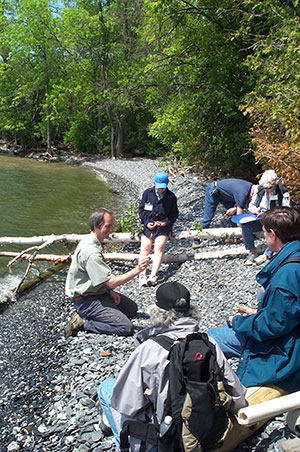History of the Program
 The PLACE Program concept emerged in the late 1990s from conversations between Walter Poleman (UVM Field Naturalist Program) and Megan Camp (Shelburne Farms Program Director) about how to create engaging new learning opportunities for adults. They decided to experiment by integrating the Field Naturalist Program’s approach to landscape analysis with Shelburne Farms’ natural history programming. The result was a series of six field trips known as The Nature of Shelburne that was offered to a diverse group of Shelburne residents. Educators involved in the series recognized the opportunity to link the content of the course to local school curricula, while those active in town government saw the potential to influence town planning and promote community education. It was decided that future programs should link the field trip series to evening presentations and curriculum development workshops.
The PLACE Program concept emerged in the late 1990s from conversations between Walter Poleman (UVM Field Naturalist Program) and Megan Camp (Shelburne Farms Program Director) about how to create engaging new learning opportunities for adults. They decided to experiment by integrating the Field Naturalist Program’s approach to landscape analysis with Shelburne Farms’ natural history programming. The result was a series of six field trips known as The Nature of Shelburne that was offered to a diverse group of Shelburne residents. Educators involved in the series recognized the opportunity to link the content of the course to local school curricula, while those active in town government saw the potential to influence town planning and promote community education. It was decided that future programs should link the field trip series to evening presentations and curriculum development workshops.
This new expanded vision served as the framework for the first official project of the PLACE Program, which took place in the town of Richmond, Vermont during spring 2001. Sponsored locally by the Richmond Conservation Commission, Richmond Geographic was a series of four evening presentations (free and open to the public) and a set of companion field trips for teachers and town officials. Community response was very favorable (an average of 60 adults attended each presentation), and a group of six local teachers earned graduate credit as they created place-based learning modules based on the content of the lectures and field trips. Building on the success of the Richmond pilot, PLACE Programs were offered in the towns of Jericho and Thetford, VT during spring 2002. The program came full circle geographically in 2003 with a return to the Shelburne landscape.
In 2004, Shelburne Farms and UVM received three-year planning grants from the Canaday Family Charitable Trust and the Lintilhac Foundation to develop the PLACE Institute. The idea behind the Institute model was to bring community members into the landscape analysis research process, and have them work collaboratively with graduate students to develop educational products for the community and the school system. The Institute model was piloted in the towns of Huntington and Hinesburg in spring 2005, and programming and projects were still unfolding two years later in spring 2007. During the initial phase of the Institute (a 6-month period of workshops and research), the two town teams (each composed of four community members and four graduate students) participated in a series of landscape analysis workshops and developed plans for presenting the fruits of their research to the community. In the second phase, each team engaged their community in a series of presentations, field trips, and teacher workshops. In phase three, which unfolded in spring 2007, spin-off projects, such as the development and implementation of Community Quests (treasure hunts featuring local natural and cultural history), took place in each town. The Institute model has been utilized most recently in the towns of Dummerston, Putney and Williston.
In recent years, PLACE has worked closely with Delia Clark of the Center for Place-based Learning and Community Engagement to design and facilitate a Vision to Action Forum as an integral feature of the program. Successfully piloted in Dummerston and Williston, a community vision forum will serve as a culminating event in the Campbridge PLACE Program in fall 2008.